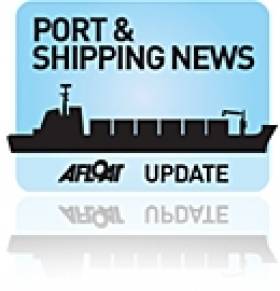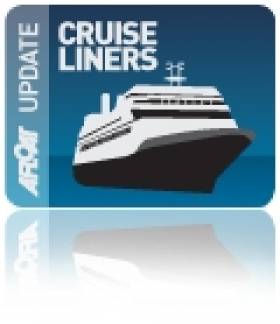Displaying items by tag: Dublin Port
Dublin Bay Oil, Gas, Coal...and Waste-Water!
The work is part of a Dublin City Council project to evaluate an extension at the Ringsend plant where treated water will be released into the bay. The council are conducting detailed feasibility studies which will be examined for an Environmental Impact Assessment.
To date the project has involved two other rigs, the Aran 250 and the larger Excalibur which remains in the bay. The barges will be towed to 20 pre-determined bore-hole locations in the bay where the jack-up rig barges operate 'legs' to sit on the seabed which enables a steady working platform. The rigs are operating on a continuous basis in an area covering most of Dublin Bay and close to the Burford Bank on the eastern fringes.
In addition a buoy will be positioned 300-metres of the barge during drill operations, which is expected to take approximately one week for each drill. For information on the location of the bore-holes, they can viewed from the Dublin Port website by clicking HERE The project is expected to be completed in late Spring.
Several support craft are engaged in the project that recently included the Seabed Worker, a 3,923 gross tonnes Norwegian anchor-handling tug supply vessel (AHTS) the tugs Multratug 7, MTS Valiant and Trojan and the RIB-craft sisters, Brian Boru and James Joyce which are on standby duties. Like the Trojan, the 12-seater RIBS are based at the Poolbeg Yacht Club Marina where in the tourist season the craft provide excursions in Dublin Bay for Sea Safari Tours. In October the project also required the services of the yellow-hulled catamaran, Xplorer to carry out a bathymetric survey of Dublin Bay. The larger tugs and rigs are based opposite in Alexandra Basin / Ocean Pier.
The largest drill-rig working to date on the project, the Excalibur arrived under the tow of the Multratug 7 on a misty morning on Christmas Day. Due to the weather conditions the red-hulled craft slipped quietly into the port. Several days later the imposing looking craft re-emerged with its six-towering jack-up 'sea-legs' that jutted skywards into an otherwise horizontal expanse of Dublin Bay.
The sight of the rig has presented many onlookers to mistakenly believe the drilling was for oil!...Not so but the assumption is not surprising given the reports last year of an oil-field discovery named the Dalkey Island Prospect. The name for the oil-field was referred to Dalkey, as the coastal suburb on the southern shores is the nearest landfall to the exploratory well sites at the Kish Bank Basin.
In fact this kind of exploratory activity was again to confuse residents throughout the bay when the drill-ship, Fugro Synergy was offshore at the Kish Bank between December 2009 and early Spring of 2010. Though on this occasion the search was not for oil but coal!
During this period the 5,200 tonnes vessel equipped with a drill-tower, seemed to be a near permanent feature on the horizon. A series of drill-wells up to 3,500-metres were conducted when the 2009 built ship was contracted to Irish based VP Power Ltd, to determine the commercial viability of extracting coal from the sea for generating electricity. The Underground Coal Gasification (UCG) project is a process where coal is heated in underwater rock reservoirs to extract gas, essentially converting gas-from-coal energy. Otherwise this method is commonly referred to as a 'clean' technology.
In addition to last year's search for deposits of large coal seams under the seabed, there was reports of a significant natural resource in the form of oil!... when several exploratory blocks again in the Kish Bank Basin were surveyed. The company behind this venture, Provident Resources, another Irish based exploration company, conducted initial oil surveys using air-born craft and as such no actual drill-based ships or rigs were used. Though should any oil flow, such an operation would be required.
Incidentally the Excalibur is designed also to perform offshore wind turbine installation work and is equipped with a 250-ton crane to hoist the wind-farm components. The vessel is operated by Fugro Seacore, a subsidiary of the Dutch parent company, Fugro, which also managed the drill-ship Fugro Synergy.
Ferry-Go-Round on the Irish Sea
In the case of Irish Ferries, their Rosslare-Pembroke Dock route vessel, Isle of Inishmore arrived on the Mersey yesterday at the Cammell Laird dry-dock facility in Birkenhead.
The 1997 Dutch-built Isle of Inishmore had relieved the 50,938 tonnes 'flagship' Ulysses from the Dublin-Holyhead route which too had gone to Birkenhead for maintenance since January 4th.
The Ulysses is now back on service and the company's French routes cruiseferry, Oscar Wilde is covering the Isle of Inishmore's absence from Rosslare-Pembroke Dock sailings.
Continental services to France on the Rosslare-Cherbourg route will resume on February 16th when the Oscar Wilde returns from her overall. The Bahamas flagged vessel will re-open seasonal Rosslare-Roscoff sailings starting on May 13th.
In addition to conventional tonnage Irish Ferries also operate the fast-craft catamaran Jonathan Swift in tandem with Ulysses on the Dublin-Holyhead route. The Ulysses takes 3 hours 25 minutes while the 39-knot catamaran craft marketed as the Dublin 'Swift' is advertised with a scheduled passage time of 1 hour and 49 minutes.
The Australian-built catamaran was taken off the central corridor route yesterday to be drydocked also in Birkenhead until January 18th. Dublin Swift sailings return to the Dublin-Holyhead route on February 19th with the first crossing to depart at 14.30 hours from the capital port.
For the latest information on ferry sailings and reservations click: www.irishferries.com
Vacancy at Seatruck Ferries
Seatruck Ferries, the only Irish Sea ferry company, dedicated solely to the carriage of freight, are looking to appoint a Group Operations Manager. The position is based in their Heysham office in Cumbria. In addition the appointment would require regular travel to Seatruck's other terminals on both sides of the north Irish Sea.
The company operates the Dublin-Liverpool, Warrenpoint-Heysham and Heysham-Larne routes which are served by an eight-strong fleet. In recent years four Spanish built newbuilds were commissioned into service on the Dublin-Liverpool and Warrenpoint-Heysham routes. Each newbuild has a 120 freight unit capacity.The remaining four vessels where built in 1998 and they can each handle 65 freight units.
Seatruck's Dublin Port operations is located at the Alexandra Basin terminal close to the East-Link Toll-Lift Bridge and the Point Village.
To find out more about the vacancy (including PDF) logon HERE and in general about the company click www.seatruckferries.com The closing date for applications is 31 January.
Salt Shipments Bound for Cork
In total the National Roads Authority (NRA) will have 25,000 tonnes of salt available during the Christmas week, with 3,000 tonnes distributed to authorities on a daily basis. As a priority the salt will be used to grit the national primary network.
The second bout of artic conditions that has gripped the country with temperatures plummeting to -17 degrees in the west and -15 degrees is forecast tonight in the north-west. Further snowfalls are also due in various regions tonight and with sub-zero temperatures expected to last up to St. Stephens Day. As such the demand for salt supplies has soared resulting in shipments sourced from overseas countries to include Turkey and Egypt.
CFL Prospect (see video-clip here) is owned by the Dutch shipping company, Kees Koolhof which since 2006 has built up a fleet of modern vessels to trade in the short-sea sector. The 2007 built vessel is one of nine Jumbo 6500s from a series completed by the Peters Shipyard at Krampen.
For the latest NRA's road weather stations logon here in addition to weather forecasts from www.met.ie
Stealth Frigates to Visit Dublin Port
Two Dutch naval frigates, HNLMS Tromp and HNLMS Van Amstel are due to arrive into Dublin Port tomorrow for a courtesy visit over the weekend, writes Jehan Ashmore.
The Royal Netherlands Navy HNLMS Van Tromp is a De Zeven Provinciën-class air-defence and command frigate (LCF). The class has a striking streamlined visual appearance, through the use of stealth design technology. The stealth design is to minimise the vessels signature as much as possible from the detection of enemy vessels using radar.
At 6,050 tonnes, the stealth frigate is one of five built by the Royal Schelde Group, of Flushing, Netherlands. Spain and Germany also participated during the design stage of the 144-metre class which are powered by gas turbine engines capable of reaching 30 knots.
They are equipped with an Oto Breda 127 mm cannon, vertical launch system (VLS) Mk 41 for Evolved Sea Sparrow Missile (ESSM), Standard Missile and Harpoon Missiles. In addition the frigate has a Goalkeeper (rapid-fire gun), a Oerlikon 20 mm machine gun and a Mk. 46 Torpedo weapon system. The vessel also has the ability to carry a Lynx or NH-90 helicopter.
The second frigate to visit the capital is HNLMS Van Amstel, one of two multi-purpose M-class frigates. The frigate which is also known as the Karel Doorman class can be used for surface warfare and anti-submarine warfare. They also have their own air-defence capabilities.
The 122-metre vessels displace 3,300 tonnes and have a two Rolls Royce (Spey 1A) gas turbines delivering 29 knots. The class are equipped with an array of defence / attack armament to includes an Oto Melara 76 mm gun for surface and air targets, a Harpoon weapon system and a NATO Sea Sparrow Vertical Launch weapon system for use against air targets at close range. Like the De Zeven –class the M-class frigate is also capable of carrying a Lynx helicopter.
Royal Navy Anti-Piracy Frigate Visits Dublin Port
The Royal Navy's Type 22 frigate HMS Chatham (F87) which recently returned to UK waters after a seven month deployment on anti-piracy duties off Somalia, visited Dublin Port last weekend, writes Jehan Ashmore.
HMS Chatham was the lead vessel for NATO's 'Operation Ocean Shield' as part of a multi-national task force in the seas off the African state that in recent years has become notorious for piracy.

HMS Chatham departs Dublin Bay and the rocks off Dalkey Island. Photo: Jehan Ashmore /ShipSNAPS
The frigate departed Dublin on Monday afternoon and set an easterly course off the Baily Lighthouse, but surprisingly the 5,300 tonnes vessel returned into the bay. HMS Chatham then crossed the bay towards Sandycove. From there the 148m vessel which has a draft of 6.7m veered in a south-easterly direction, to sweep past off the rocky outcrop, to the north of Dalkey Island and continued southbound off The Muglins.
In mid-November the frigate visited her namesake port on the Medway to mark the 20th anniversary since the vessel's commissioning at Chatham in 1990. The occasion was also the first time that such an event had taken place outside a Royal Navy establishment.
Built in 1988, the vessel was launched from the Swan Hunter shipyard on the Tyne and is normally based in her homeport of Devonport, Plymouth.
Sheila Tyrrell to Chair New Sail Training Group
The new umbrella organisation Sail Training Ireland includes a number of key sailing people involved in sail training in Ireland including the chief executive of the Irish Sailing Association Harry Hermon and Seamus McLoughlin the head of operations of Dublin Port Company. The group also includes Kalanne O'Leary, a former member of Coiste an Asgard, the state board that ran Asgard II. The full group, chaired by Sheila Tyrrell, has been named as follows:
Sheila Tyrrell, Chair
Harry Hermon, ISA Chief Executive
Philip Cowman ISA Director, Ex Harbour Master Waterford
Kalanne O'Leary, Irish Representative on Sail Training International
Seamus McLoughlin, Head of Operations, Dublin Port
Sean Flood, Sail Training International Ambassador – Ireland.
Looking for further reading on Tall Ships in Ireland? Click the links below:
Click this link to read all our Tall Ships Stories on one handy page
Previewing Ireland's Tall Ships 2011 Season
Can Ireland Get a New Tall Ship?
Dublin Port Tugs Making Magic 'Rainbow' Happen
The spectacular effect of the life-size rainbow had never been achieved before in Ireland. Steve Green, the director of the advertisement used a 35mm film, with footage from HD cameras, including one mounted on the helicopter which hovered over the 'new' landmarks of the 'Docklands'.
The imaginative advertisement was created by Sweet Media, the production company chosen to produce the campaign, under the direction of the National Lottery's advertising agency, DDFH&B. The soundtrack for 'Making Magic Happen' is the appropriately titled 'Pocketful of Rainbows', sung by Elvis Presley. The version used is Take 16 from the 1960 recording sessions for the 'G.I. Blues' soundtrack.
As for the stars of the advert, the tugs are named after Irish figures, Shackleton, named in honour of Antartic explorer Sir Ernest Henry Shackleton and Beaufort, named after Navan-born, Sir Francis Beaufort, who created the world-renowned wind-scale measurement.
The 50-bollard ton tugs cost €6m each and were built at the Astilleros Zamakona Shipyard, Bilbao. In March the tugs officially entered service after a joint naming ceremony was held in Dublin Port.
To view the tugs in water-firing, making magic mode!... click the link here
Frostbite 'Cruising'
This morning the 28,388 gross tonnes cruises-ship Boudicca is due to arrive into Dublin Port, writes Jehan Ashmore. The visit of the 1973-built vessel will represent the second last cruise-call of this year's cruise-season. The 900-passenger capacity Boudicca will depart later today on a 10-day cruise to include calling to Cork.
The final cruise-call scheduled for Dublin Port will once again by made by Boudicca on 20 November. On that cruise the Fred. Olsen Cruise Lines ship will be returning from Cork after an overnight passage.
Next year Dublin is to welcome 86 cruise-ships, where the largest of these vessels will berth in Alexandra Quay, located 2 kms from the city centre. Smaller vessels can dock closer to the city-centre but they have to transit the East-Link toll-road lift bridge. In addition the depth of water on the River Liffey also restricts the size of cruise-ship.
Incidentally the Boudicca will be the first caller to Dublin in 2011, with a morning arrival due on 9 April. For further information on next year's cruise-call season, a list is available online at www.dublinport.ie/not-in-menu/cruise-ship-scheduled/
Ferry Passenger Boost Recorded for First Half of 2010
The figures reflect the disruption to the aviation industry due to the ash-cloud that erupted from the Icelandic Eyjafjallajokull volcanic mountain in April. This contributed to a large volume in passengers making alternative travel plans by booking with ferry operators.
During the week of the main closure to European air-space, ferry operators noted a three-fold increase in the demand for foot-passenger bookings throughout the main Irish Sea routes. The IMDO estimate that an additional 106,000 passengers took the ferry option compared to the same time period in 2009.
On the continental routes between Ireland to France, volumes increased 25% in the second quarter of 2010. There are three routes operated by four ferry operators. Over 30% of the passenger market is conducted within the second quarter of 2010, marking the beginning of the tourist season. Therefore any increase in passengers volumes from this time is likely to have a positive impact for the balance of the full year figures.
In the months between March to May, the increase in sea-passengers was up 14% year-on-year. While the market demand on English Channel routes, which accounts for 90% of the traffic, saw passenger numbers surge 13% in the second quarter of 2010 compared to the same timeframe of the previous year.
The largest percentage increase in traffic, was recorded at Dublin Port, during the first 6 months of 2010, where passenger volumes rose by 25%. Earlier in the year, a new entrant into the Irish Sea market, Fastnet Line re-opened the Cork-Swansea route. In 2006 the 10-hour route was closed by Swansea Cork Ferries. The new operator provides 6 sailings weekly which are likely to have resulted in a boost to passenger tourist vehicles in the south-west region.
On an all-Ireland basis there are 5 operators operating between Ireland and the UK, and 2 operators between Ireland and France providing 60 daily sailings. Irish Sea operators are Stena Line, Irish Ferries, P&O (Irish Sea), Seatruck Ferries and DFDS Seaways (formerly trading as Norfolkline) until acquired by the Danish ferry and transport logistics company. On the continental services, Irish Ferries and Celtic Link Ferries operate out of Rosslare Europort while Brittany Ferries serves the Cork-Roscoff route.
For a detailed PDF of the figures please click attachment listed below. For further information about the IMDO logon to their website: www.imdo.ie
































































